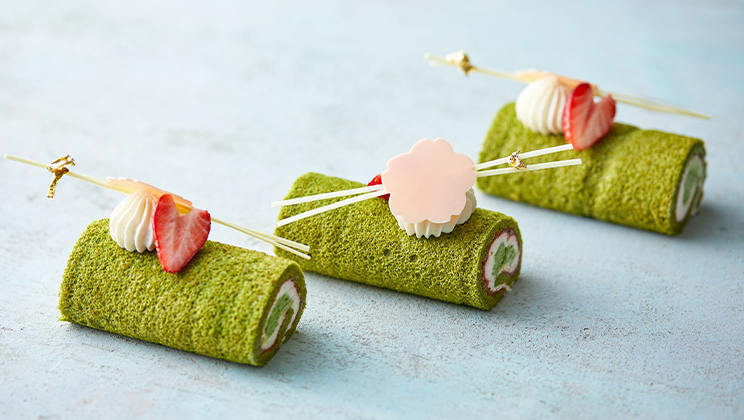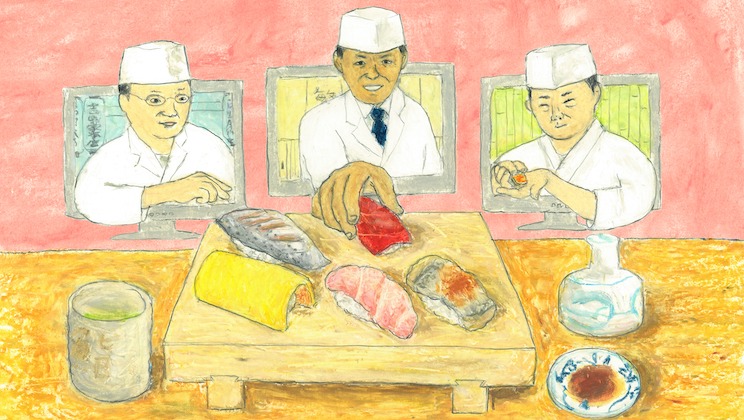Wanting to Interact with Customers and Convey the Appeal of the Product: The Life with Coffee HARIO Offers Through Its Café
Wanting to Interact with Customers and Convey the Appeal of the Product: The Life with Coffee HARIO Offers Through Its Café

HARIO Co., Ltd. will celebrate its 100th anniversary as a seasoned and well-established glassmaker next year. The company is renowned for its chemistry products and home glassware, after becoming globally-known when its V60 series coffee dripper became a hit. Then, HARIO opened its first dining venture in 2018 with the “HARIO CAFÉ,” which is intended to share the appeal of a life with coffee.For this issue, we spoke with Ms. Mari Tsujimoto of HARIO Public Relations, Ms. Nene Okawa from HARIO Lampwork Factory’s public relations team, and HARIO CAFÉ manager Mr. Fumiya Takahashi regarding their culture of balancing a mindset that values ancient artisanal techniques with a flexible stance on incorporating new ideas, and their efforts with the café.
From a chemistry equipment manufacturer to home accessories, and then a global coffee device brand.
-First, could you please tell us about HARIO’s journey so far?
Ms. Mari Tsujimoto (“Tsujimoto”): HARIO Co., Ltd. was founded in 1921, and we will be celebrating our 100th anniversary next year. The name HARIO is drawn from “hari” (a word for glass in Japanese) plus “o” for “king” in Japanese. There are many types of glass, but HARIO handles heat-resistant glass that can be used for microwaves, direct flame, or boiling water, and is also distinct in being resistant to acids and alkalis. HARIO began as a company that made beakers, flasks, and other chemistry equipment to use those traits, when we were founded.
After that, we expanded into the home item field in 1948, with our first product being a vacuum coffee maker. Since then, we’ve worked on a wide range of items including coffee devices, tea devices, kitchenware, pet dishes, and so on, and in an odd turn we also produce parts for automobile headlights. And since 2014, we’ve also started a new business selling glass accessories.
Ms. Nene Okawa (“Okawa”): Our V60 coffee dripper is particularly popular, even among our home goods. It’s a core product that represents the company right now, and it actually didn’t sell much at all when it launched in 2004. But then a man named Mr. Michael Phillips used it to win the World Barista Championship in 2010, presenting it as “an easy-to-use dripper that lets everyone from beginners to pros make delicious coffee.” Then the HARIO name really took off, suddenly. Now, the name HARIO has spread so widely that it means coffee devices, overseas.
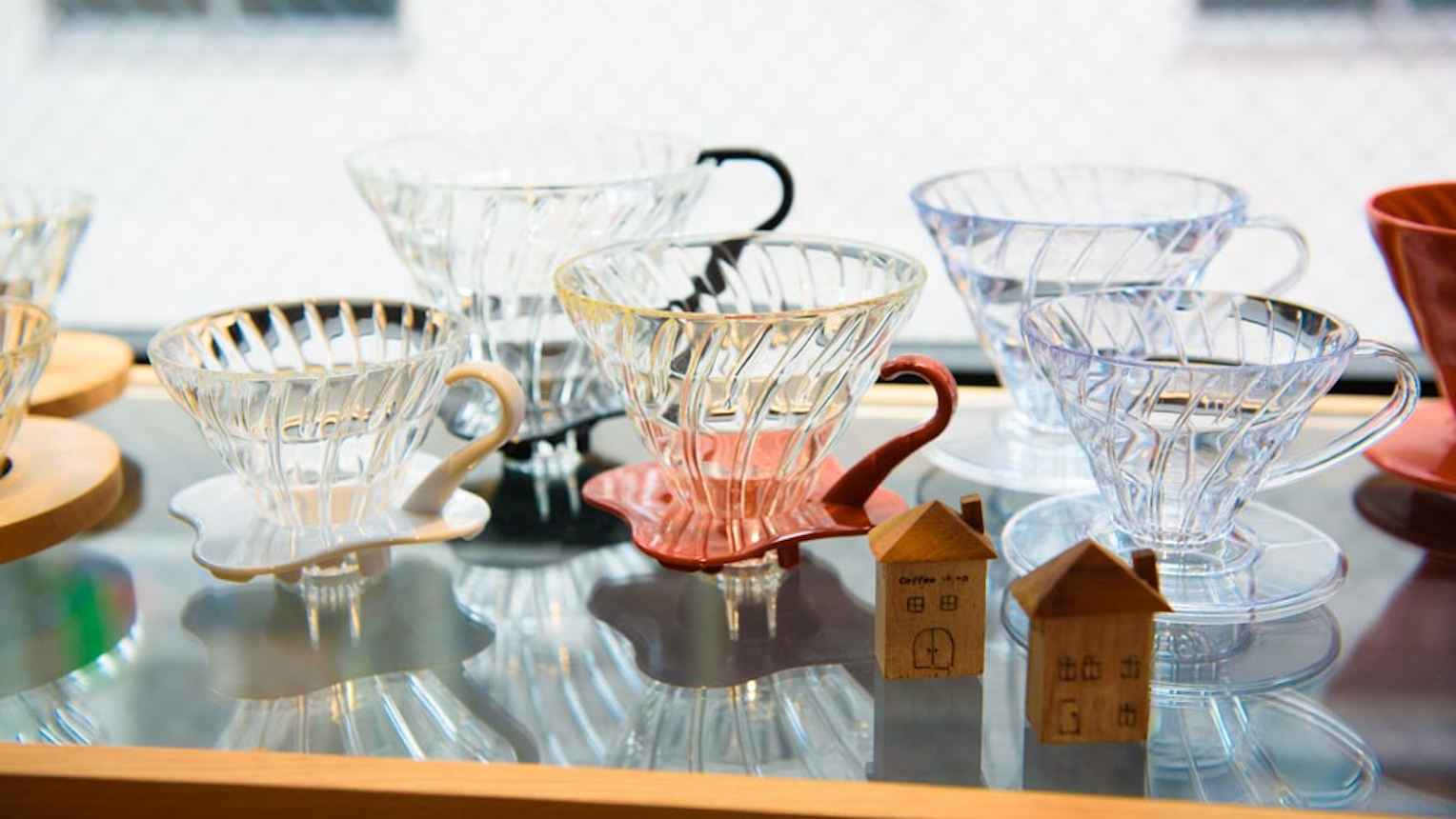
The “V60” dripper that became a sudden hit product for HARIO
We wanted a place for interacting directly with customers.
-What prompted you to open the café?
Tsujimoto: We moved our HQ to Nihonbashi in 2000, and a lot of people said that “it’s a beautiful building, so you should make part of it into a café” at the time (HARIO’s HQ is located in a renovated bank building originally constructed in 1932, and is a designated cultural property). But at that time, we were an equipment manufacturer and didn’t think of ourselves as specialized in food.
Still, when we decided to open the “Lampwork Factory” glass accessory brand store in Muromachi, Nihonbashi, someone brought up the idea of an adjoining café that conveyed the appeal of coffee, if we were going to have a brick and mortar storefront. Then we all decided we might as well try it, and the plan came together in a flash.
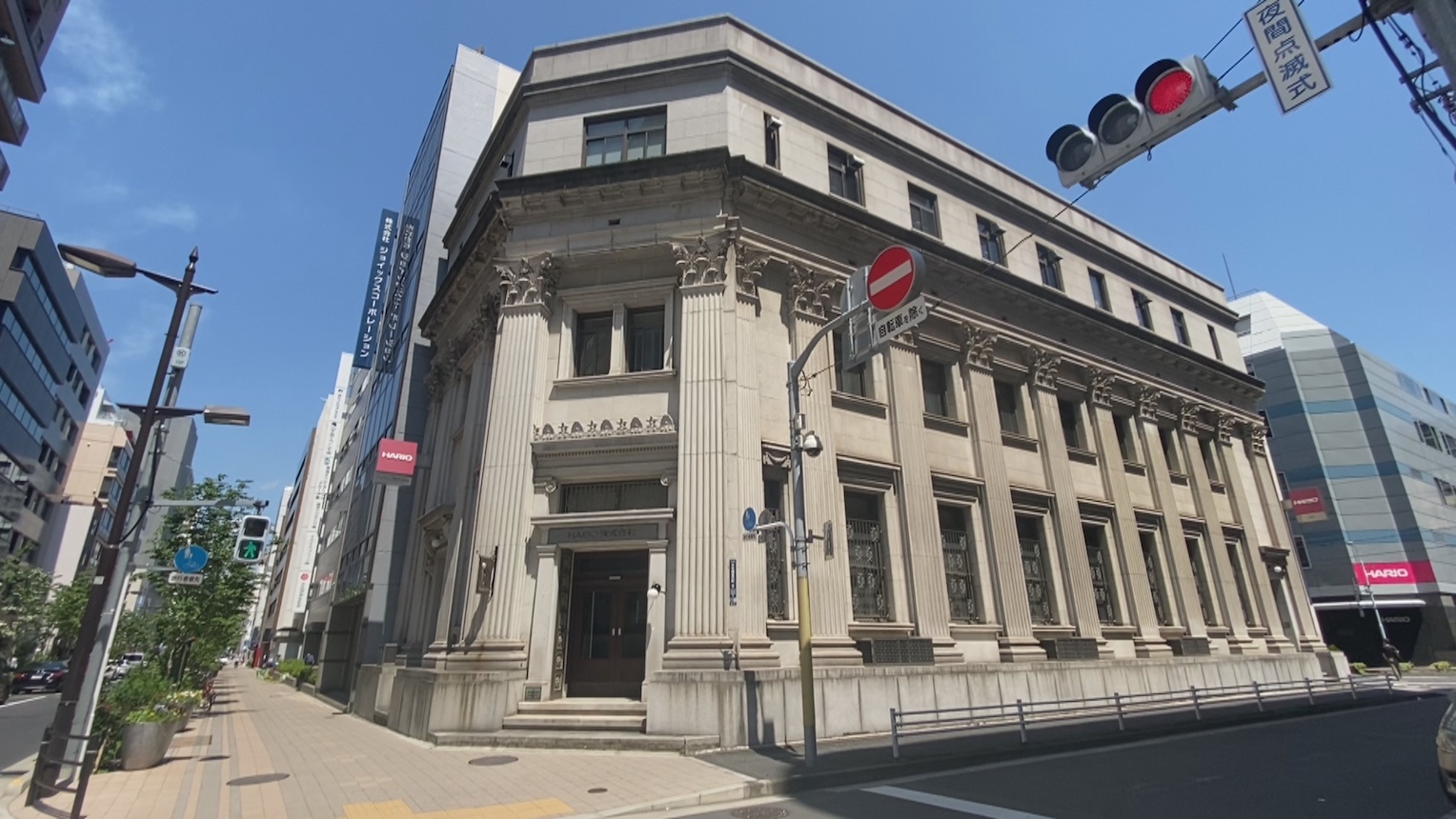
The exterior of the HARIO HQ (Image provided by: HARIO)
Okawa: One major issue was that while HARIO made a wide range of products, as a manufacturer, we didn’t have opportunities to speak with end user customers directly. So we opened storefronts in a sort of showroom-like capacity, and most of all out of a desire to interact with customers and convey the unique traits and usage of our devices, for the HARIO CAFÉ.

Ms. Okawa from the Lampworks Factory’s PR team
Tsujimoto: That’s right. Of course we also need to sell coffee and make a profit, but the café’s role is to convey the appeal of coffee using HARIO items. We also think of it as a place to spread information via people enjoying delicious coffee our baristas brew, then letting them enjoy that at home.
-And you selected Mr. Takahashi as the barista who brews the delicious coffee?
Mr. Fumiya Takahashi (“Takahashi”): Before this job, I worked as a barista for a coffee shop in Hatchobori, and participated in barista championships and coffee-related exhibitions in addition to serving customers coffee. And I happened to know the person in charge of launching the HARIO CAFÉ since that shop stocked items from HARIO. With that connection, I eventually ended up running the HARIO CAFÉ, which is where I am now.
-Could you tell us about the coffee you serve at the HARIO CAFÉ?
Takahashi: The coffee beans we use at the HARIO CAFÉ are high grade beans known as specialty coffee. We order them from PHILOCOFFEA in Chiba Prefecture, CAFFE CALMO in Nihonbashi, and WOODBERRY COFFEE ROASTERS, which has locations in Yoga and Shibuya. For the record, PHILOCOFFEA is the roaster owned by Mr. Tetsu Kasuya, who won the 2016 World Brewers’ Cup coffee competition, also using a V60 in that case.
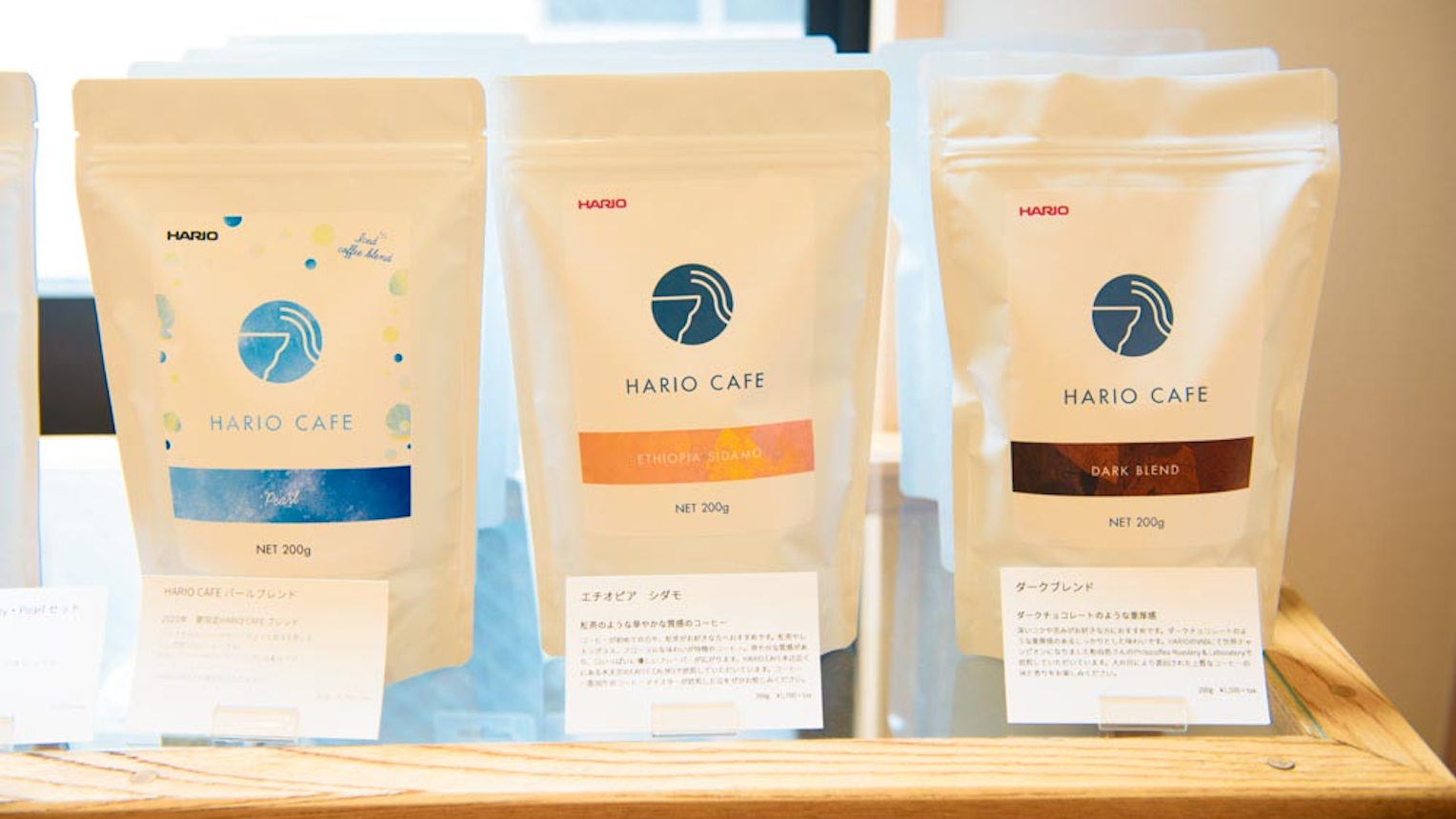
Customers can purchase the coffee beans used at the café
Okawa: Naturally, we are selective on our coffee, as well as our interior furnishings, like the brick motifs built into our walls. They’re made in the image of the kilns we use to melt glass. They represent our identity as the only current company with a heat-resistant glass plant in Japan. Our third floor features rows of non-coffee products, and is designed creatively all over to act as a true HARIO showroom. One of our team members has a 1st degree architectural license, and worked on this to reflect opinions from within the company.
-It’s a very authentic café, and you can feel the passion that went into it, can’t you?
Takahashi: The café’s concept is “to make a delicious cup of coffee for our customers,” and I think there are three main things we can do to live up to it. Ms. Okawa just mentioned the first, which is to let customers actually see and learn about HARIO products. The second, naturally, is to serve quality coffee and let them experience it. And the third is to hold workshops to help people experience great coffee at home.

Mr. Takahashi, the HARIO CAFÉ’s manager, participating in a barista competition
-What sort of things can participants learn from the workshops you hold?
Takahashi: Generally, we have everything from introductory hand-dripped coffee classes for people who have never brewed coffee before, to introductory classes for people with a bit of experience, and so forth, with classes on drip-brewing based on student levels.
Our café might be a bit distinct in that we also have classes that let students handle new products, and classes for comparing device usage. HARIO offers paperless drippers, cloth-filtered nel drippers, and more in addition to the V60, so it would be hard to try them all out at home. So letting people compare their use and flavor at workshops also creates an opportunity to learn their own tastes. I like it when people participate to learn about how to enjoy coffee at home. Also, we have classes on using vacuum coffee makers – which a lot of customers requested – and classes on seasonal coffee blends. In summer we teach people how to make good iced coffee, and in winter we cover latte art on café au lait.
-What sort of students do the workshops draw?
Takahashi: My gut sense is that the majority of our guests are women, and their ages cover a wide range. I feel like a lot of women love coffee right now.
Okawa: A lot of department stores and apparel shops also display coffee items now, too. Being able to brew coffee yourself might be starting to meld into our lifestyles now, regardless of sex or age. Also, more people are trying to enjoy their time at home during the coronavirus pandemic, and I feel like the trend just keeps getting stronger.
-You recently launched an online shop; was that also a response to the increase in at-home needs during the coronavirus pandemic?
Okawa: We launched an online shop on April 1st (add link), but we had always planned that. It wasn’t related to the novel coronavirus. We also started streaming workshops on Instagram around the same time, so we ended up able to communicate with our customers through video and guide them to our online shop for purchases when we had to close down. We were able to generate a good turn of events that way.
The café offers ways to enjoy coffee over both its Instagram and YouTube channel (Video provided by: HARIO)
Takahashi: At first we were selling a lot of coffee beans, but as we continued streaming, we started selling dripper introductory sets and items we used in the videos, and found that we could connect with customers even without a real-world location. We also sometimes answered questions as people entered them in the video comments, which made for fun interactions.
You can make new ideas a reality with the “all else aside, let’s try everything” spirit.
-From what you’ve said, HARIO is breaking in to new sectors even as an older, established business. I feel like there must be some routine challenges involved in that. Could you give us some background on the corporate culture behind that?
Okawa: Our management’s attitude is “let’s do everything, and take on every challenge,” so that might have spread throughout the company and our affiliates. Our greatest strength is owning our own heat-resistant glass plant, and glass has a wide range of applications, from chemistry equipment to dishware and accessories. I feel like our philosophy of using that strength to try everything is at the root of things.

The café displays and sells artisanal glass accessories on its first floor
Tsujimoto: For example, the “Lampworks Factory” on the first floor of the HARIO CAFÉ came from an idea from the company’s leadership inspired by the 2011 Tohoku earthquake and tsunami. We use electric power to melt glass in the HARIO plant, but the power went off when the earthquake surprised us on March 11th, 2010, and we had to shut down one of our two kilns. We wanted to use the glass that was left over in it somehow, and someone had an idea for making accessories for the current chair of the board. The attitude at the time was very closed off, generally. But the effort to create something with dreams and hope other than home goods or chemistry equipment, and something that only we could do, that all tied into our current brand.
Glass accessories were also significant in a sense of looking back to our corporate origins and trying to make something using hand-crafting techniques. We have robots doing mass production in our plant now, but we wanted to deliberately revisit and revive artisanal glass crafting techniques and the significance of hand-crafted work.
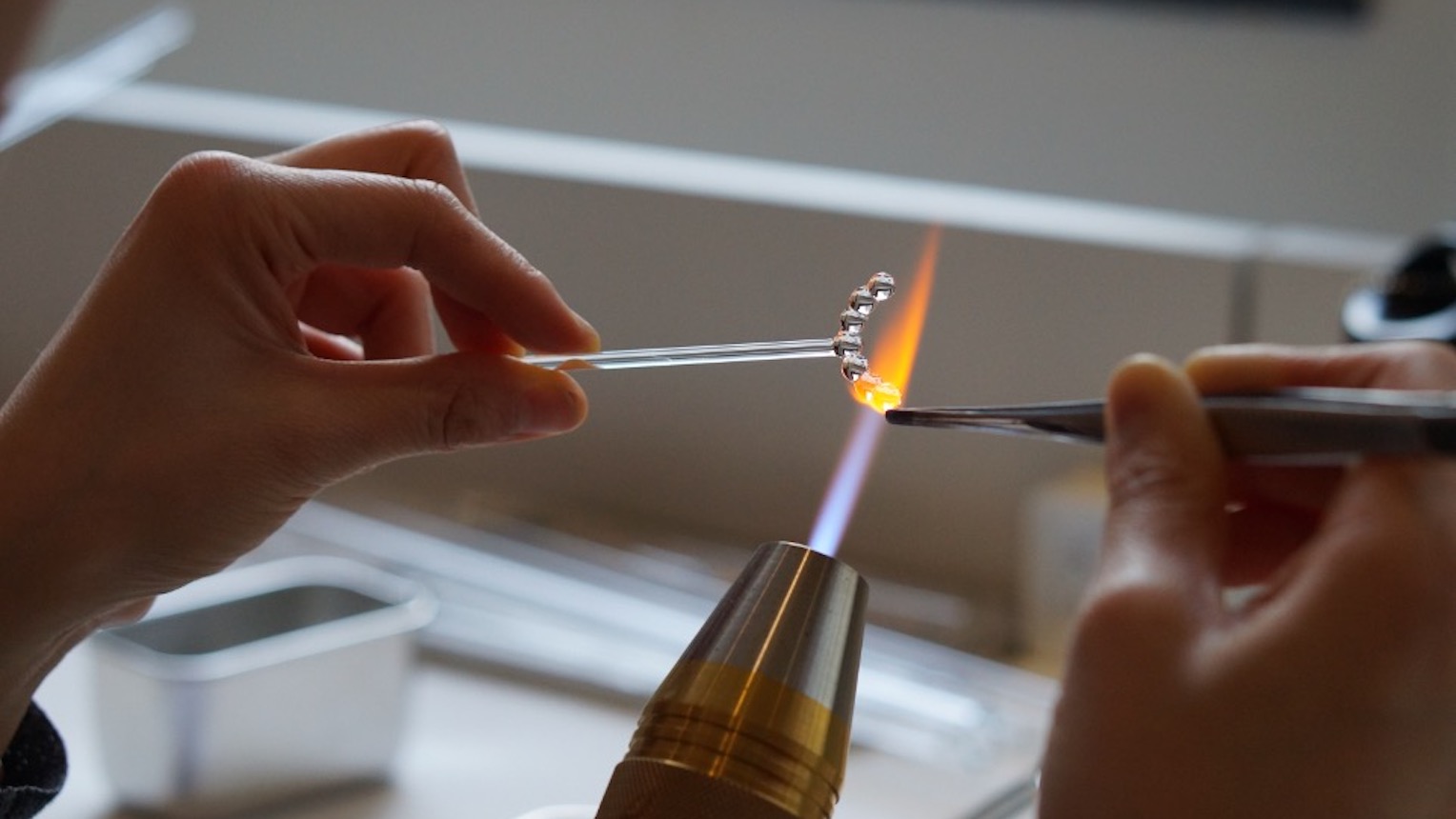
An artisan hand-crafting a glass accessory (Image provided by: HARIO)
-The company seems proactive in using employee ideas. Is that right?
Tsujimoto: We generally implement employee ideas rather than outsourcing for craftsmanship, too. We have a venue for all employees to submit ideas for what they want to make, annually. The management selects the best ideas out of the ones they get, and the company makes the final decision on making them into products. For example, our glass-lidded ceramic rice pot came from that initiative. We felt it was definitely more fun to make rice when you could see it happen, where normal pots don’t allow that. Being a glass company, we want everything to be transparent (laughter).

The ceramic rice pot created from an employee idea submission (Image provided by: HARIO)
Connecting with the world while staying true to the Nihonbashi community.
-Your HQ is in Tomizawacho, your café is in Muromachi, and the Lampworks Factory is in Denmacho, so you’re fully clustered in the Nihonbashi neighborhood. Are you attached to Nihonbashi, as a city?
Tsujimoto: Our HQ is located in a renovated former bank building, originally build in 1932. We heard the previous owner wanted to pass the building on to someone who would keep it intact, and HARIO shares the spirit of “using aged items,” so we moved here in 2000.
Takahashi: I think we built our café in Muromachi out of a desire to broadcast to the world. The V60 in particular took off in popularity overseas first, drawing attention in Japan in a sort of re-imported way, and all else aside it has a lot of fans outside Japan. In the sense of communicating with the world outside Japan, it’s important that it’s located near Tokyo Station and the Mandarin Oriental Hotel, both of which a lot of foreign tourists use. Honestly, about one third of our customers at the HARIO CAFÉ are foreign. They visit after finding out HARIO has a café in Tokyo, or show us items on their phones and ask if we sell them.
-You seem like you must be connected to the local community, as a company. Is that right?
Tsujimoto: While they haven’t been happening recently because of the novel coronavirus, we’re involved in ongoing local cleaning volunteer work regularly. Also, separately, the neighborhood council has a cleaning committee, and we’re also members of that. This area has taken care of us for 100 years, as a company, so we stay true to it like you might expect.
-I’ve heard that you’re opening the second HARIO CAFÉ in Japan this autumn, branching off from Nihonbashi into Nagoya’s commercial complex “Hisaya Odori Park.” How will the café be different from the one in Nihonbashi?
Tsujimoto: Our Nagoya café will use its location in a park. While our Nihonbashi location is urban, the Nagoya location lets customers enjoy the natural setting for a different atmosphere. We are also expanding overseas development in Indonesia and other countries, and expect that to grow in the future. We view the world as our venue, and want to spread the word about HARIO’s good points to everyone.
-Finally, please share some future challenges you want to take on at the HARIO CAFÉ.
Okawa: I’d like to strengthen our café original merchandise development, and content for experiences that are only available there. For example, we currently sell glass and hand towels, but foreign customers tend to focus on made-in-Japan products that are only sold at a location like our Nihonbashi café. Also, we’re developing original café cups and saucers. We’re currently talking with ceramics artisans about making café original items, for that. I want to increase the amount of HARIO-style unrestricted imagination with that sort of unique value.
Interview and text: Yuri Nakajima, photography: Daisuke Okamura
HARIO Co., Ltd.
A heat-resistant glassmaker founded in 1921 in Kanda Sudacho, Tokyo. After beginning from chemistry equipment, the company now designs, manufactures, and sells home items, medical equipment, and other items. Their “V60” coffee dripper is a notable global hit even among their other coffee-related items. In March 2018, HARIO opened the “HARIO CAFÉ” in Muromachi, Nihonbashi in order to share the appeal of the company’s coffee items with users directly.
https://www.hario.com/
Online Shop
https://www.hario.co.jp/
HARIO CAFÉ
Opened in Muromachi, Nihonbashi in March 2018. The first floor consists of the “Lampwork Factory,” which displays and sells glass accessories, while the second and third floors make up the café. In addition to serving hand-dripped coffee and light meals made by its baristas, this café also holds workshops. It currently streams lessons on how to enjoy delicious coffee at home via YouTube and Instagram.
https://hariocafe-lwf.com/
